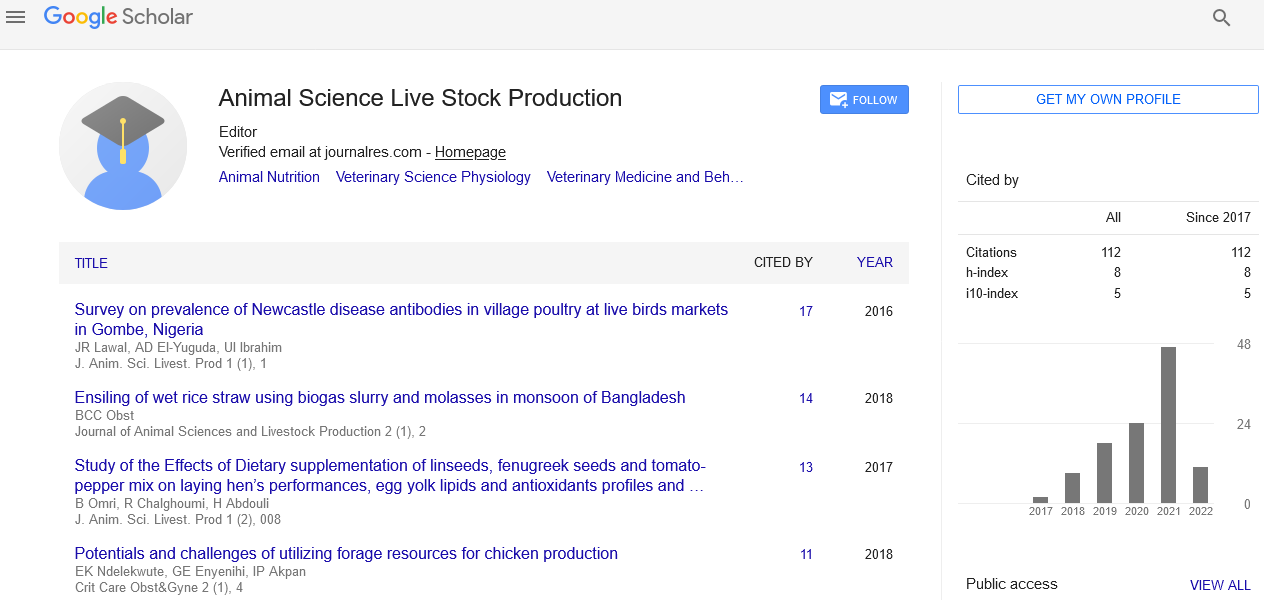Commentary - (2024) Volume 8, Issue 4
The Fascinating World of Animals: Diversity, Importance, and Conservation
Riku Yamaguchi*
Department of Animal Sciences, Osaka University, Japan
*Correspondence:
Riku Yamaguchi,
Department of Animal Sciences, Osaka University,
Japan,
Email:
Received: 02-Dec-2024, Manuscript No. IPJASLP-24-22162;
Editor assigned: 04-Dec-2024, Pre QC No. IPJASLP-24-22162 (PQ);
Reviewed: 18-Dec-2024, QC No. IPJASLP-24-22162;
Revised: 23-Dec-2024, Manuscript No. IPJASLP-24-22162 (R);
Published:
30-Dec-2024, DOI: 10.36648/2577-0594.8.4.32
Description
Animals are an integral part of life on Earth, contributing to the
balance of ecosystems, the food chain, and human well-being.
From the smallest insect to the largest mammal, the animal
kingdom is full of diversity and complexity. In this article, we
will explore the vast world of animals, their importance to
the environment and humans, and the critical need for their
conservation. Animals can be found in nearly every habitat,
from the deepest oceans to the highest mountains, and from
the hottest deserts to the coldest polar regions. Broadly,
animals are classified into two categories are vertebrates
and invertebrates. Vertebrates have a backbone or spine and
include mammals, birds, reptiles, amphibians, and fish. This
diversity also extends to animal behavior, feeding habits,
reproduction, and physical characteristics. For example, while
some animals are herbivores, feeding primarily on plants, others
are carnivores, relying on other animals for food. Animals play
a crucial role in maintaining the health of ecosystems. They are
key components in food webs, acting as both predators and
prey. Herbivores consume plants, helping control vegetation
and maintain plant biodiversity, while carnivores help regulate
populations of herbivores and other predators. Pollination,
which is essential for plant reproduction, is another critical
role performed by many animals. Bees, butterflies, birds, and
even bats are primary pollinators, ensuring the survival of
countless plant species, including many that humans rely on for
food. Pets, such as dogs and cats, have long been companions
to humans, offering emotional support and contributing to
mental well-being. The bond between humans and animals is
also evident in many cultures, where animals are revered for
their symbolic significance, such as the cow in Hinduism or
the eagle in Native American traditions. Furthermore, animals
have been crucial in scientific research, contributing to medical
advancements and helping us understand diseases, genetics,
and even behavior. Unfortunately, many animal species are
currently facing significant threats. Habitat destruction, climate
change, poaching, pollution, and overhunting are among the
primary causes of declining animal populations. For example,
the destruction of forests and wetlands, often due to agriculture
and urban development, reduces the natural habitats of
countless species, pushing them toward extinction. Climate
change exacerbates these issues, altering migration patterns,
breeding cycles, and the availability of food and water. Rising
temperatures and changing weather patterns threaten species
that are unable to adapt quickly enough. Poaching and illegal
wildlife trade, particularly of endangered species like elephants
and rhinoceroses, have devastated populations and driven
some species to the brink of extinction. Pollution, including
plastic waste in oceans, is another major threat to marine life,
affecting everything from fish to sea turtles. Organizations
around the world are working to protect endangered species,
preserve natural habitats, and combat illegal wildlife trade.
Conservation is not only about saving animals but also about
preserving biodiversity, which is essential for the health of our
planet. By protecting animals and their habitats, we ensure
that ecosystems continue to function properly, providing clean
air, water, and food for all living organisms, including humans.
Animals are not just a part of nature; they are vital to the
well-being of our planet and humanity. Their diversity, roles
in ecosystems, and contributions to human societies highlight
their significance. However, the increasing threats they face
underscore the urgency of conservation efforts. By protecting
animals and their habitats, we help ensure a balanced,
sustainable world for future generations.
Acknowledgement
None.
Conflict Of Interest
None.
Citation: Yamaguchi R (2024) The Fascinating World of Animals: Diversity, Importance, and Conservation. J Animal Sci. 8:32.
Copyright: © 2024 Yamaguchi R. This is an open-access article distributed under the terms of the Creative Commons Attribution License, which permits unrestricted use, distribution, and reproduction in any medium, provided the original author and source are credited.

